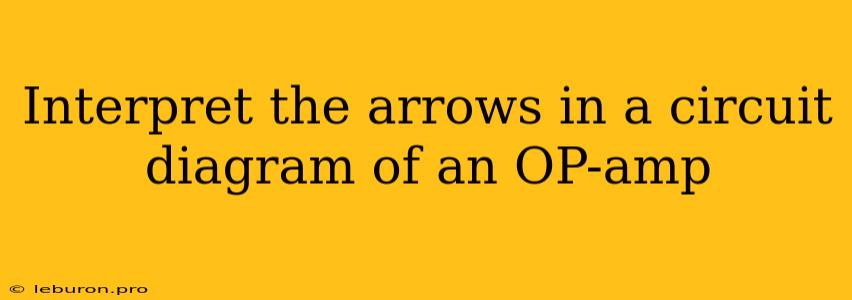Circuit diagrams are the language of electronics, providing a visual representation of the components and their interconnections within a circuit. Operational amplifiers, or op-amps as they are commonly known, are versatile and ubiquitous components found in a vast range of electronic applications. They are often depicted in circuit diagrams with a set of arrows, which might seem cryptic at first glance. This article delves into the meaning of these arrows and how they help us understand the behavior of an op-amp within a circuit.
Understanding the Arrows in an Op-Amp Circuit Diagram
The arrows in an op-amp circuit diagram represent the direction of current flow, specifically the input and output signals. These arrows are crucial for interpreting how the op-amp amplifies and manipulates the input signals.
Input Arrows
Op-amps typically have two input terminals, denoted as inverting (-) and non-inverting (+). The arrows pointing towards these terminals indicate the direction of the input signal.
- Inverting Input (-): The arrow points towards the inverting input. This signifies that a positive input signal at this terminal will result in a negative output signal. Conversely, a negative input signal will result in a positive output signal.
- Non-inverting Input (+): The arrow points towards the non-inverting input. This signifies that a positive input signal at this terminal will result in a positive output signal. Similarly, a negative input signal will result in a negative output signal.
Output Arrow
The output terminal of the op-amp is usually represented by an arrow pointing away from the terminal. This arrow indicates that the output signal is generated by the op-amp and flows out to the rest of the circuit. The direction of the output arrow is often not explicitly stated but is generally understood as flowing away from the output terminal.
The Significance of Arrows in Op-Amp Circuit Analysis
The arrows in an op-amp circuit diagram are essential for understanding how the op-amp functions. They help us:
- Identify input and output signals: By understanding the direction of the arrows, we can easily identify the input and output signals.
- Determine the polarity of the output signal: The arrows help us predict whether the output signal will be inverted or non-inverted based on the input signal polarity.
- Analyze the overall behavior of the circuit: By tracing the path of the arrows through the circuit, we can understand how the op-amp interacts with other components and influences the overall signal flow.
Illustrative Examples
Let's consider some common op-amp circuit configurations to solidify our understanding of the role of arrows:
- Inverting Amplifier: In an inverting amplifier, the input signal is applied to the inverting input (-), and the output signal is taken from the output terminal. The arrow pointing towards the inverting input indicates that a positive input signal will result in a negative output signal.
- Non-inverting Amplifier: In a non-inverting amplifier, the input signal is applied to the non-inverting input (+), and the output signal is taken from the output terminal. The arrow pointing towards the non-inverting input signifies that a positive input signal will result in a positive output signal.
- Differential Amplifier: In a differential amplifier, two input signals are applied to both the inverting and non-inverting inputs. The output signal is taken from the output terminal. The arrows indicate that the output signal will be proportional to the difference between the two input signals.
Conclusion
The arrows in an op-amp circuit diagram are a critical element in comprehending the behavior of the op-amp. They represent the flow of input and output signals, allowing us to determine signal polarity, predict output behavior, and analyze the overall circuit operation. By understanding these arrows and their significance, we can effectively analyze, design, and troubleshoot circuits incorporating op-amps.
Remember that these arrows provide a valuable tool for navigating the complexities of op-amp circuits and enable us to predict and control their behavior. As you delve deeper into the world of electronics, always pay attention to the arrows in circuit diagrams, as they hold the key to unlocking the intricacies of op-amp operation.
